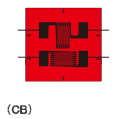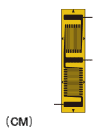TML strain gauges are used not only for the purpose of knowing strain/stress but also as sensors for strain gauge type transducers. A strain gauge type transducer converts physical quantity such as load, pressure or displacement into mechanical strain on the strain generating body (elastic body), and the mechanical strain is converted into electrical output using strain gauges mounted on the elastic body. We offer various types of transducer-specific strain gauges featuring highly reliable and stable performance.
- Force transducers (Load cell)
- Pressure transducers
- Acceleration transducers
- Displacement transducers
- Torque transducers
VARIOUS TYPES OF TML TRANSDUCER-SPECIFIC SRAIN GAUGES
GAUGE SHAPE AND GAUGE LENGTH
Single, Rectangular 2-element, Torque (Shearing) strain measurement
| Pattern | Gauge length (mm) |
|---|---|
| Single-element | 2, 3, 6 |
| 90° 2-element | 2, 3, 6 |
| Torque (Shearing strain) use | 2 |
Pattern
| Single-element | Single-element | Torque | Torque |
 |
 |
 |
 |
| 0°/90° 2-element | 0°/90° 2-element | ||
 |
 |
2 types of 90° 2-element gauge are lined-up with different pattern of gauge tab. CM-type has half-bridge configuration.
GAUGE RESISTANCE
| Pattern | Gauge resistance |
|---|---|
| Single-element | 350, 1000 |
| 90° 2-element | 120, 350 |
| Torque (Shearing strain) use | 350 |
*1000-ohm gauge has less power consumption in bridge circuit comparing to 350-ohm gauge's and limits Joule's heat generation.
GAUGE BACKING MATERIALS
Unlike stress measurement gauges, the gauge backing materials for transducer-specific strain gauge cannot be determined based solely on the operational temperature and bonding method. To ensure maximum transducer performance, it is necessary to test various combinations using different stress-generating bodies (elastic bodies) to select the most suitable backing materials.
OPERATIONAL TEMPERATURE RANGE
| Gauge series | Gauge base materials | Operational temperature |
|---|---|---|
| F | special plastic resin | -196 to + 150℃ |
| QF | Polyimide resin | -20 to + 200℃ |
| EF | Polyimide resin | -20 to + 200℃ |
Operational temperature differs from heat-resistant temperature.
F series gauge having epoxy resin is available with heat-curing type bonding adhesive.
Adhering conditions for C-1 adhesive
| Pre-curing | Post-curing | |
|---|---|---|
| Pressurization | 200 to 300 Pa | Depressurization |
| Heating | 120 to 130℃ | 200℃ |
| Time | 2 hours | 1 hour |
Temperature compensation
The same as with strain gauges for stress measurement, self temperature compensated strain gauges for soft steel, stainless steel, and aluminum are available. Building a bridge circuit with a self temperature compensated strain gauge allows a temperature-compensated bridge circuit to be formed easily. Adding a resistor for zero point compensation allows even higher-accuracy temperature compensation.
* EF series is for soft steel.
CREEP ADJUSTMENT
The creep characteristic is particularly important in force transducers. The most common compensation system uses the material creep (+) of the stress-generating body (elastic body) and the gauge creep (-) to cancel each other. Various TML strain gauges are available for creep adjustment and are selectable by creep code.
Creep code
| Gauge creep |
|
|---|---|
| Creep code |
|
| FLAB series FCT-2-350 series |
|
TEMPERATURE SENSITIVITY COMPENSATION
Elastic modulus of srain-generating body (elastic body) varies with temperature variation. In the same manner, as ambient temperature around the strain-generating body varies, resulting in change of apparent strain. To reduce such temperature influence, sensitivity compensation resistor is assembled in bridge circuit.
Detailed specifications must be discussed and decided before ordering gauges for transducers.
Consult your sales representative.
More Information


